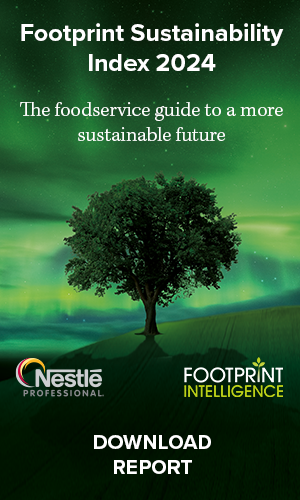Extensive and higher welfare production systems often come with a higher environmental footprint, new research has found, but there are caveats aplenty. Nick Hughes reports.
What does ‘better’ meat look like in a foodservice context? That was the question Footprint sought to answer in a 2021 report – A Caterer’s Guide to Better Meat. Back then a new narrative was emerging around the need for businesses in high income and high meat consuming countries like the UK to help people eat ‘less and better’ meat in order to achieve their own and the nation’s climate and nature goals and unlock a range of social and ethical benefits such as higher animal welfare and lower use of antibiotics.
Fast forward three years and while experts including the Climate Change Committee and Henry Dimbleby (in his national food strategy) have sought to model precise scenarios for the ‘less’ aspect of ‘less and better’ in a UK context, the question of what constitutes ‘better’ meat remains fuzzy to say the least.
Enter the World Resources Institute (WRI): in April the organisation published a new report that explores the different definitions and attributes of better meat and seeks to put some hard data behind the question of what better meat actually looks like. It then also offers up steps that businesses can take to design a sourcing strategy that will allow them to achieve their climate and nature goals.
The headline finding may make uncomfortable reading for those who tie definitions of better meat to alternative agricultural production systems and methods, such as organic, pasture-raised, grass-fed, free-range and regenerative. WRI’s analysis found that shifting to these kinds of production systems commonly associated with better meat (and identified as such in our Footprint report) often results in higher environmental impacts per kilogram of protein.
Researchers compared the environmental performance of conventional and alternative animal production systems using nearly 300 environmental data points from 45 studies conducted in North America and Europe between 2000 and 2022. They found that greenhouse gas emissions were higher in more than 70% of cases in alternative systems, while the amount of land needed under systems marketed as better was higher than under conventional systems more than 90% of the time. These differences for both GHG emissions and land use were statistically significant for beef, dairy, pork, poultry, and eggs.
‘Pick ‘n mix’ approach
Yet the findings come with some caveats, chief among which is that ‘better’ meat remains a highly subjective concept with those who use the term tending towards ‘pick n’ mix’ definitions that span a wide range of environmental, social and economic indicators. Among the various attributes often afforded to better meat, according to WRI, are better environmental performance relating to climate, land, water use, water quality, biodiversity and soil health; better social and ethical performance encompassing animal welfare, local sourcing, livelihoods, nutrition and public health, antimicrobial resistance, equity, and social justice; and economic performance in respect of quality and profitability.
Add all these indicators into the mix and you inevitably encounter trade-offs. A focus on optimum land use efficiency, for example, could lead to agricultural intensification and overuse of fertilisers or pesticides (including in the production of feed) along with high stocking densities which could have negative outcomes for animal welfare.
The report highlights how companies might be tempted to shift purchasing from beef toward chicken for climate reasons (to lower GHG emissions), but to produce a ton of protein more than 100 times as many chickens than cows need to be slaughtered. And recent attention on farm pollution has also laid bare the wider issues of increasingly intensive poultry production systems.
Meanwhile, shifting to more extensive production systems could reduce antibiotic use in animals – and so help reduce the risk of antibiotic resistance – but drive up GHG emissions per kg of protein.
There are potential trade-offs too between health and the environment. Animal-based foods are protein-rich and dense in micronutrients such as iron and B vitamins. WRI notes how populations in some regions of the world, including South Asia and sub-Saharan Africa, could benefit from increased per capita consumption to boost nutrition, irrespective of higher emissions.
Foodservice focus
Within the UK foodservice sector, much of the current focus on animal protein is linked to meat reduction initiatives aimed at supporting corporate net-zero goals. A third of dishes on Sodexo’s centrally designed menus are now plant-based, helping drive a 36% reduction in scope 3 emissions in FY23 compared with a FY17 baseline.
There is recognition within Sodexo that emissions intensity could be reduced more rapidly by sourcing intensively reared meat but that would run contrary to its broader ambition to source less and better.
Reducing emissions has “got to be done holistically to sit alongside all the commitments we have made in areas like responsible sourcing, higher welfare, local and seasonal”, Claire Atkins Morris, Sodexo UK & Ireland sustainability director, told Footprint earlier this year.
WRI says that if a company’s analysis suggests that shifting sourcing to better meat will result in higher environmental impacts from its supply chain, it should move beyond a ‘less meat’ strategy to an ‘even less meat’ strategy to stay on track for its environmental targets.
Another recommendation is for businesses to define their specific priorities around improved meat sourcing by protein type. For example, for beef the goal might be to reduce climate and land impacts both through sourcing less of it and through encouraging lower-emissions production methods. For chicken and eggs, a goal of improving animal welfare, promoting responsible antibiotic use and minimising water pollution could be prioritised.
Missing indicators
One area of likely contention surrounding WRI’s analysis is its decision not to evaluate the effects of different farming systems on on-farm biodiversity and soil health, the reason being that most life cycle assessments (LCAs) do not yet account for these indicators.
One of the main claimed benefits of regenerative agriculture versus conventional farming is its positive effect on biodiversity and soil health – the theory being that when animals are integrated into mixed farming systems they can reduce reliance on artificial inputs by helping to spread organic matter and increase nutrient cycling. This is often through rotational or ‘mob’ grazing whereby animals are frequently moved between small areas of pasture to help stimulate plant growth and build soil organic matter.
Proponents of regenerative agriculture have also made some bold claims around the potential to achieve carbon reductions and removals in the supply chain via carbon sequestration, the impacts of which are again not captured by WRI since it says these “can be complex and hard to predict”.
‘Less’ debate
Efforts to measure and standardise on-farm sustainability outcomes are ongoing through initiatives like the Global Farm Metric. Fast forward three more years and we might reasonably expect to have a better view of what better meat looks like across a much wider range of indicators, although it seems fanciful to believe that trade-offs won’t still exist.
Yet in countries like the UK, the national debate has yet to move much beyond the argument for eating less meat overall – something organisations like WRI (and plenty of others) see as a fundamental starting point for reducing meat’s impact. Neither of the main two political parties – the Conservatives and Labour – will publicly entertain the idea of telling people to eat less meat, while the national levy board, the AHDB, ran a controversial ‘Let’s Eat Balanced’ TV campaignthroughout January promoting consumption of red meat and dairy.
The sustainability of meat and dairy production has also taken on a distinctly nationalist bent. In a 2021 paper titled, ‘The facts about red meat and milk’, the National Farmers Union (NFU) stated that “British red meat and dairy has a great story to tell” with British beef and lamb “among the most efficient and sustainable in the world”. To help support the claim it highlighted a Climate Change Committee report which found greenhouse gas emissions from UK beef are about half the global average (48kgCO2e per kg of meat from dedicated beef herds versus 99kgCO2e per kg). Yet the paper simultaneously failed to acknowledge the committee’s recommendation for at least a 20% shift away from beef, lamb and dairy to alternative protein sources per person by 2050.
National differences in environmental and social impact (not covered by the WRI analysis) have a legitimate role to play in the debate around better meat. However the consensus is increasingly that, for wealthy nations, eating less meat at a population level is non-negotiable. Published in March, a survey of over 200 climate scientists and food and agri experts carried out by the animal law and policy programme at Harvard Law School found that 85% agree that it is important that human diets shift from livestock-derived foods to livestock replacement foods to align with the Paris Agreement, with the most substantial shifts occurring among people in high- and middle-income countries.
Eating better meat, however it’s defined, is a worthy aspiration; but the evidence is clear that eating less meat overall holds the key to reducing livestock’s impact on the planet.












